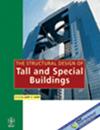钢与钢纤维混凝土组合柱界面的耗能与损伤
IF 1.3
3区 工程技术
Q3 CONSTRUCTION & BUILDING TECHNOLOGY
引用次数: 1
摘要
为了解决钢筋混凝土(SRC)在施工中面临的问题,如钢筋和钢筋之间的位置冲突或混凝土浇筑困难,提出了一种新型的“钢和钢纤维混凝土”(SSFRC)复合结构。本文对34根SSFRC复合柱进行了推出试验,从耗能的角度研究了其界面粘结性能。基于荷载-位移(P‐D)曲线,介绍了界面能量耗散(Wb)和能量耗散因子(λ),并分析了嵌入长度(Le)、钢纤维体积率(ρsf)、混凝土保护层厚度(Css)和截面类型对Wb和λ的影响。试验结果表明,圆形柱在Wb和λ方面优于方形柱。Le、Css或ρsf的增加有利于Wb的改善,λ与ρsf和Css呈正相关,但与Le呈负相关。此外,界面损伤(Da)由弹性变形能(Wa)和Wb之间的关系来定义。可以得出结论,Le和Css的上升分别能有效地延缓Da的出现和抑制Da的发育,并且在后期加载阶段,Da随着ρsf的增加而缓慢发展。本文章由计算机程序翻译,如有差异,请以英文原文为准。
Energy dissipation and damage on the interface of steel and steel fiber‐reinforced concrete composite column
To address the problems faced with steel‐reinforced concrete (SRC) in construction, such as positional conflicts between steel and steel bars or difficulty in pouring concrete, a novel “Steel and Steel Fiber‐Reinforced Concrete” (SSFRC) composite structure was proposed. Push‐out tests of 34 SSFRC composite columns were carried out in this paper to study the interfacial bond performance from the perspective of energy dissipation. Based on loading‐displacement (P‐D) curves, the interfacial energy dissipation (Wb) and energy dissipation factor (λ) were introduced, and the influence of embedded length (Le), steel fiber volume rate (ρsf), thickness of concrete cover (Css), and section type on Wb and λ were analyzed. Test results indicated that circular column is better than square column in terms of Wb and λ. The increase of Le, Css, or ρsf is beneficial to the improvement of Wb, and λ is positively correlated with ρsf and Css but negatively correlated with Le. Additionally, the interfacial damage (Da) was defined by the relationship between elastic deformation energy (Wa) and Wb. It can be concluded that the ascent of Le and Css can effectively delay the appearance of Da and inhibit the development of Da, respectively, and Da develops slowly with the increase of ρsf at the later loading stage.
求助全文
通过发布文献求助,成功后即可免费获取论文全文。
去求助
来源期刊
CiteScore
5.30
自引率
4.20%
发文量
83
审稿时长
6-12 weeks
期刊介绍:
The Structural Design of Tall and Special Buildings provides structural engineers and contractors with a detailed written presentation of innovative structural engineering and construction practices for tall and special buildings. It also presents applied research on new materials or analysis methods that can directly benefit structural engineers involved in the design of tall and special buildings. The editor''s policy is to maintain a reasonable balance between papers from design engineers and from research workers so that the Journal will be useful to both groups. The problems in this field and their solutions are international in character and require a knowledge of several traditional disciplines and the Journal will reflect this.
The main subject of the Journal is the structural design and construction of tall and special buildings. The basic definition of a tall building, in the context of the Journal audience, is a structure that is equal to or greater than 50 meters (165 feet) in height, or 14 stories or greater. A special building is one with unique architectural or structural characteristics.
However, manuscripts dealing with chimneys, water towers, silos, cooling towers, and pools will generally not be considered for review. The journal will present papers on new innovative structural systems, materials and methods of analysis.

 求助内容:
求助内容: 应助结果提醒方式:
应助结果提醒方式:


